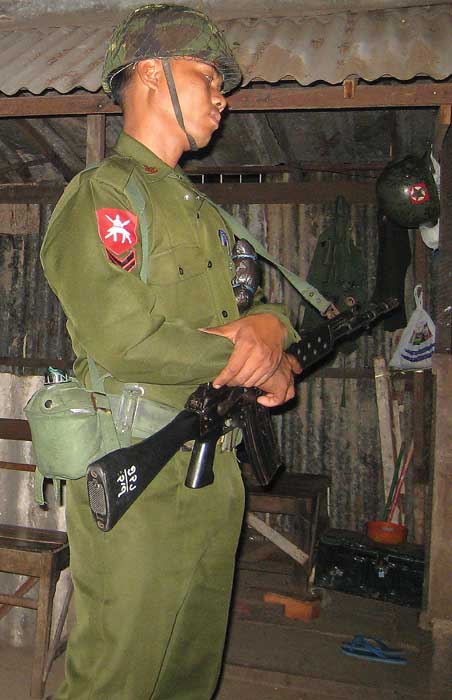
(The Government of Burma changed its name to Myanmar following the 1988 demonstrations within the country. Most people still call the country “Burma,” as the new name of “Myanmar” is considered by many to be an attempt to erase the memory of the students of 8/8/88, who protested and died for ideals that they believed would make their country into a free and independent democratic nation. It has not worked out that way. SAR will use “Burma” for international recognition purposes. – V. Kenneth.)
The isolated State of Burma (Myanmar) plays a very small role in international affairs today. Burma is an unfrequented country with tight government controls, danger in the mountains, and a politically inflamed climate. It is wedged in between developing Thailand and expanding India. Mostly overlooked and virtually anonymous in the Western world, Burma has declined in its international presence due to the current military dictatorship that begin with the coup in 1961 lead by General Ne Win, who died in 2002. General Than Shwe is currently the head of state. Being a police state under military rule, Burma’s army has always played a decisive role in the history of the Southeast Asian nation. Called the “Tatmadow” in the local dialect, the Burmese Army was formed in January 1948 with the independence of the country from Great Britain. Groups of irregulars and an officer corps that came from the “Thirty Comrades,” a select group of Burmese officers trained by the Japanese during the country’s occupation during World War Two, were melded into the new Burmese military. Being a British colony prior to the war, the armed forces were based on the British operating structure and chain of command. Burma’s initial small arms inventory included SMLEs, No.4s, Bren Guns, Sten MkIIs and a variety of other British firearms.
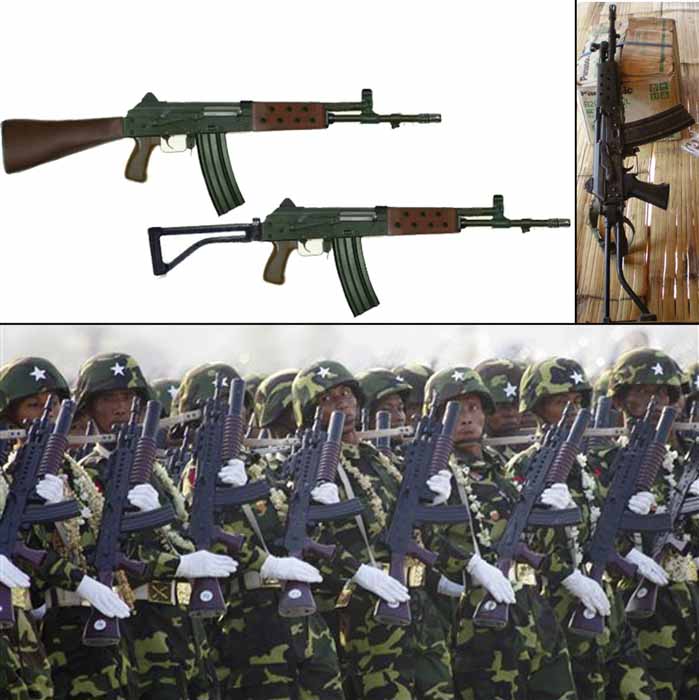
As the 1950s rolled by, the inventory was greatly expanded from a variety of sources. American Military Assistance Programs (MAP), Foreign Military Sales (FMS), British assistance up until 1954, and several other countries helped to increase the quantity and variety of weapons in the inventory. TZ-45 submachine gun licenses were bought from Italy, and the TZ-45 was manufactured locally under the designation BA52 in 9x19mm. Israeli sales to Burma included fifty thousand rifles in 1954. China sold weapons to Burma, and Thailand contributed sales of Thai HK33s or captured rifles from the northern insurgents. Most importantly, Burma received much help from West German government owned Fritz Werner Industry Ausrustungen-Gmbh (FRG), an arms company that sold Burma rifles and machinery to locally manufacture a variety of the Heckler and Koch G3 series. The G3 was designated the BA72, and as such the 7.62x51mm G3 was Burma’s main battle rifle for the next forty years of service.
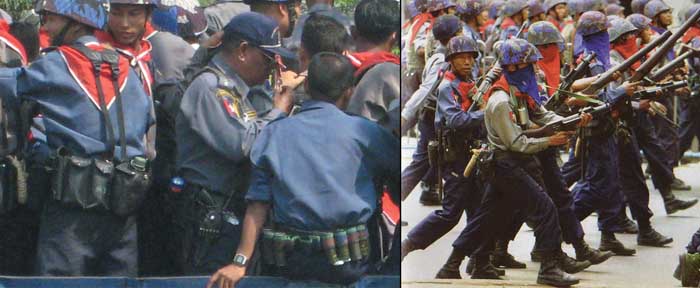
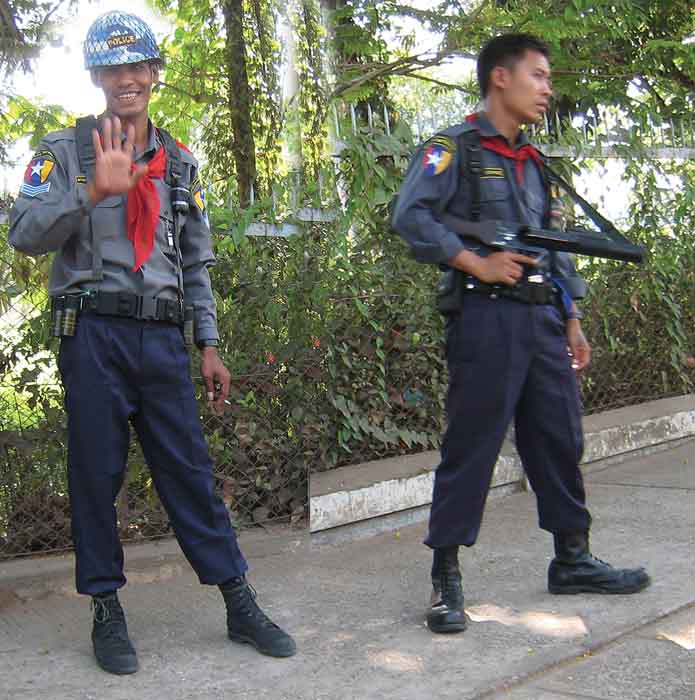
Much of the world had switched over to the 5.56x45mm platform by the 1970s and 1980s, but Burma’s transition did not occur until the late 1990s with the new Myanmar Army (MA) rifle. Up to this point much of Burma’s small arms had been bought, copied, or captured. The development of the MA series marked the first truly Burmese design that was almost independent of foreign parentage, but showed many influences. Soon after this development, the EMER K1 was discovered by the Western Press. Most recently, in September of 2007, during the “Saffron Revolution” two 40x46mm low velocity grenade launchers appeared that the Burmese had developed and produced on their own. This point in time (late 1990s to present) marks the beginning of a new era in Burmese small arms development; one of innovation and inventiveness. Though the basic designs are often replicated from elsewhere, they are Burma’s first developments undertaken by its own government in its short history of independence.
BA Series Rifles
A licensed version of the 7.62x51mm Heckler & Koch G3 had been in Burmese production since Fritz Werner exported and sold the rifles and machinery to Burma after several negotiations started in 1953. By the time of the military takeover in 1961, the military was armed with German made HK G3s. In the decades following, with the help of H&K, the German Technical Corporation Agency and Fritz Werner, weapons and ammunition factories were set up around Rangoon and elsewhere to produce G3s with the Burmese model designation of BA72 (Burma Army 72). Several variants were produced: a folding stock version designated as the BA63, a copy of the G3A3ZF marksman’s rifle designated as the BA100 and a magazine fed light machine gun version with a bipod, carrying handle and enhanced handguard with ventilation ports. Burma utilized the G3 from the 1960s up until the late 1990s, when the MA weapons platform took over and replaced it in active service. BAs may still occasionally be seen at police posts throughout Rangoon, as well as at remote military outposts and in the hands of insurgent groups.
MA Series Rifles
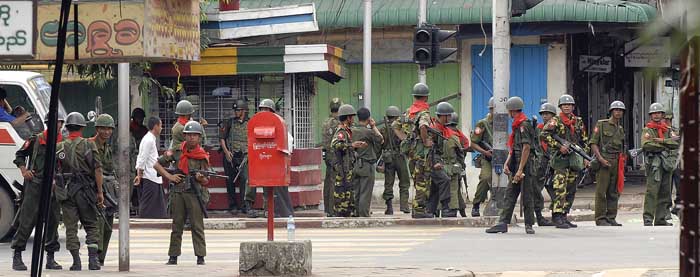
As the western world gradually switched over to the 5.56x45mm platform, Burma followed suit and created a number of variants, embarking on a journey that would lead to a new battle rifle of that caliber. The first step was to follow the example of the German HK33 and G41 rifles. Prototypes were made locally with attempts to copy both rifles as accurately as possible but with a number of changes by the Burmese. These alterations included experiments with a PPS 43 style top-folding stock, and a new style of wooden handguards to ease production. Burmese markings were used for the selector, make and model number. Burmese selector markings are either the German SEF markings or the equivalent in Burmese characters. Experimentation proceeded with the G41 and HK33 approaches at the same pace. Out of these prototypes came a limited production run of the precursor to the MA1, the MA11. The MA11 is a delayed blowback roller locked action 5.56x45mm select fire battle rifle that was fielded in the late 1990s and early 2000s. It had one other variant, the MA12, which was a magazine fed light machine gun (LMG) version and the only differences were the addition of a bipod, carrying handle, and heavier barrel. The MA11 could mount a bayonet (same as used on the MA1) and furniture was made with either brown pistol grip, stock and black handguard or simply all black. The handguard had a single row of ventilation ports that ran parallel to the barrel on both sides of the handguard. The magazine was of Burmese design, similar to the H&K magazine and release system. Magazines are interchangeable between both firearms. Sling attachments are a simple stud to the left of the front sight and a ring on the left side of the buttstock. After the development of the MA11, Burma realized that it could no longer rely on West German assistance for help with their service rifles and in turning to Israel the government found a viable partner. Israel and Burma have had a long history of collaboration although neither country publicly admits to that. In 1991, an Israeli team visited Burma and sold a number of Uzis, and assisted the government in producing them locally as the model BA94. Singapore helped with the machines and tooling required for weapon production, even producing and sending Burma a prefabricated factory (all of this occurring after the bloody 1988 demonstrations).
Burma completely abandoned any hopes of continuing with the G3 action as a platform due to West Germany’s new political stance on dealing with Burma, and they began experimentation on a Galil type platform. Taking Israeli Galils and reconfiguring them so as to manufacture them in Burma, Burma produced a number of prototypes with wooden handguards, 20-round magazines, and a magazine fed LMG version. At the end of this period, there emerged four distinct models: MA1, MA2, MA3, and MA4. All were initially produced with brown polymer furniture and the early production stages utilized rounded, smooth pistol grips while later ones had clear cut Galil grips. Later versions were produced with black furniture.
The MA1 is the basic, standard issue main battle rifle. Disassembly and operating functions are identical to the Galil though there are a number of differences with many Burmese innovations. The handguards have ventilation ports in a double staggered row along both sides. There is no pistol grip thumb selector. The rifle’s stock has a classic trapdoor for cleaning supplies, which the Galil lacks as issue Galils had the side folding stock. There is a bayonet mount and stud on the MA. The rear sight is a simple open “U” notch sight with protecting triangular ears. One undocumented report from an individual with live fire experience states that the rifle is consistently inaccurate and cannot hold a zero due to the vibration of the receiver cover during recoil.
The MA2 is the magazine fed LMG version, the only changes being the carrying handle, handguard, bipod, and a longer, heavier barrel. The handguard differs in having two rows of horizontal ventilation holes parallel to the barrel. The rear sight is the H&K drum type.
The MA3 is the carbine version of the rifle. The stock is similar to the Galil side folding stock and has a recoil pad. In this variant the thumb selector is located just like the Galil thumb selector on the left, above the pistol grip and MA3 also operates the AKM type selector on the right. The stock is usually never seen folded as it takes a good amount of pressure to depress the lock and the help of a solid object to balance the weapon on. Other than the folding stock and selector there is virtually no difference between the two rifles. All MA3s seen have been in black while MA1s are a mix of black and brown furniture depending on early and late production. Soldiers sometimes tie the sling to the metal tubes of the folding stock as the swivel is out of commission.
The MA4 is the under barrel grenade launcher (UBGL) variant of the MA series, it being equivalent to the M16 with M203. The 40x46mm low-velocity UBGL is copied from the M203 and has brown furniture for the polymer handgrip. It has two rows of ventilation ports above it for the rifle barrel and has no thumb selector. The rifle rear sight is still present as is a grenade launcher sight graduated for the standard 40x46mm low-velocity cartridge, and is located above the ventilation ports.
All four rifle types have three selector settings; safe, semiautomatic, and fully-automatic. There are no burst limiters. Markings are present above the magazine on the left side of the magazine well consisting of a circle with the Defense Industries triangle within it, and the firearm serial number which is stamped on the barrel and receiver cover as well. Of five serial numbers collected by the author, manufacture blocks C-K were represented. This means that the firearm has only been in production within the last 10 years or so. The Burmese continued where the Israelis left off. Israel never fielded a dedicated LMG or UBGL version of the Galil in large numbers whereas the Burmese did.
40mm Launchers
Other than the under-barrel grenade launcher used on the MA4 rifle, Burma has a stand-alone, single shot, break open 40x46mm launcher. The Burmese 40mm grenade launcher is simply called “40mm” by those in the service. It is an M79 design copy but employs many Burmese features. The pistol grip and stock are both brown polymer, not one being seen in black although there is mention of it. The barrel swings out to the right about 40 degrees, enough to slide in one 40mm grenade. The pistol grip is hollow with a screw up the middle to attach it to the receiver. It has no slant or curve whatsoever and is perpendicular to the barrel. The stock has a butt trap door for cleaning supplies. The open “U” sights are graduated to 300 meters with 50 meter increments. The sight must be raised up in order to fire. There are a number of metal rings surrounding the barrel in between the front and rear sights, that serve as a handguard or gripping surface. The barrel can be opened by a catch that is pulled to the rear. The selector is a switch on the left side that points forward for “safe” and up for “fire” and the operations are indicated by F or S. The front sight is protected by two very large ears that hold the front sight blade down the center and this can be flipped up. The rifling is very prominent, and there is some crowning at the muzzle. The only markings on it are on the right in bright white letters with three lines stamped “40MM”, “Grenade Launcher”, and a serial number. The author has collected four examples which are in blocks “B” and “D” showing that the launcher has just started serial production. Some examples observed have “Defense” stamped on them.
Two types of 40mm rounds have been seen in use: an all white round and an olive drab round with yellow lettering on it. Both are smoke rounds as the government will not issue its police forces the destructive HE fire power. Burma does have HE rounds in inventory because the army has been using M79s and M203s since some of the first MAPS and FMS programs from the United States. All the launchers are outfitted with slings. The other launcher appears to be more of a simplistic type for crowd control/tear gas. It has both a pistol and frontal grip; the frontal is reversed like the Hungarian AMD65. These are chambered in 40x46mm low-velocity, and have an odd, loop-shaped stock. The barrel is released and tilted down for break-open loading.
EMER K1 Prototypes
The EMER K1 is one of the most controversial of Burmese firearms as it represents an advanced design that received technical assistance from abroad and reports were leaked into the public news. It was designed in 1995 along with a batch of 16 firearms that were submitted for testing and evaluation by the Tatmadow’s Electrical and Mechanical Engineering Corps, rather than the Ordnance Department. It is reported but unconfirmed that the K1 was produced with significant Singaporean assistance. The K1 action is based upon the Chinese QBZ series and there are two variants. Both take 30-round STANAG magazines. In fact, the EMER K1 series takes features from the SA80, the M16 and the QBZ, cleverly combining them all into one package. The flash hider, magazine, carrying handle, flip aperture sights, bayonet stud, and sling swivels are all derivatives of the M16. The grip, arched trigger guard, trigger-fire control unit, stock and ventilation ports are all mirrored after the SA80 series. The action is modeled after the gas piston action of the QBZ and it is chambered in 5.56x45mm. The three setting selector is on the left side behind the magazine well and the charging handle is on the right side.
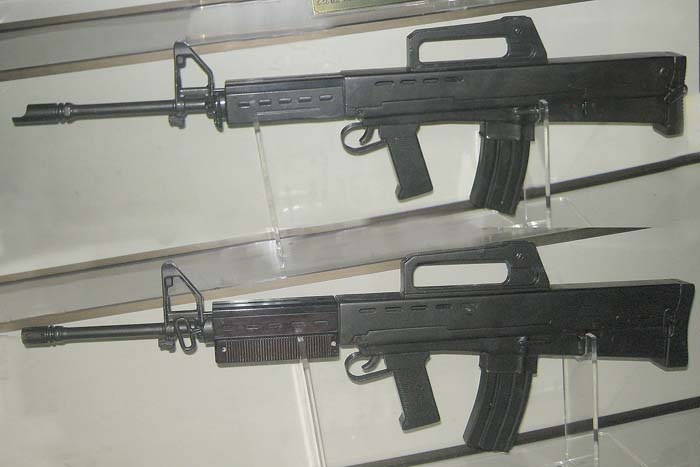
The magazine fed LMG version doesn’t differ too much from the rifle. The compensator was switched to an AKM type, heavier barrel and a new ventilated polymer handguard. There is no provision for a carrying handle or bipod. Both K1 examples fire at approximately 650 rpm. The rifle weighs 4.5 kilograms with the LMG .5 kg heavier. The EMER K1 has taken the Burmese pattern of producing a rifle and then its LMG variant. Both are accurate out to 400 meters. The rifle was reported in use on the Yadana pipeline project by reliable diplomatic sources in the late 90s but has not been seen in action or in use since then. It has taken the status of an out of line project that will not be brought back into service
Conclusion
The Tatmadow is in an experimentation stage in weapon procurement, and is coming up with inventive designs such as the EMER K1, the MA series, and 40x46mm low-velocity grenade launchers. The Tatmadow probably won’t be looking for a new service rifle for some time as the MA series and grenade launchers were just pressed into service. Probably the next firearm to come out of Burma will be a side arm or a medium or heavy machine gun in 7.62mm or .50 caliber. Their current heavy and medium machine guns, the imported MG3 and US M2HB .50 caliber (12.7x99mm) should be worn out within the next 10 years because the last M2HB procured was in the 1970s, and the last MG3 in the 1980s. If the Tatmadow doesn’t replace these machine guns with another firearm already in production, then they will probably produce their own.
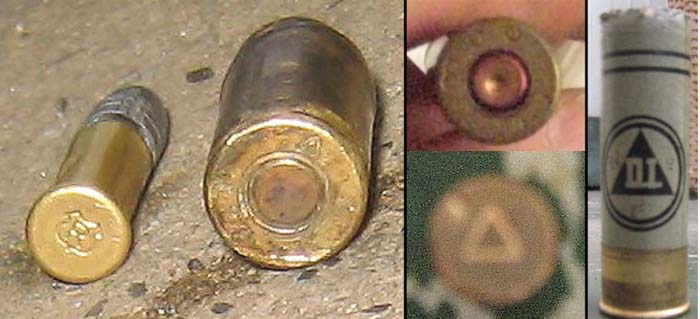
(The author has fifteen years of experience in Southeast Asia and has lived in Thailand and Burma for that time. He has studied the small arms in the region, and will be submitting a number of reports to SAR on the small arms in the region, specifically the seldom seen Burmese military weapons.)
| This article first appeared in Small Arms Review V12N11 (August 2009) |










